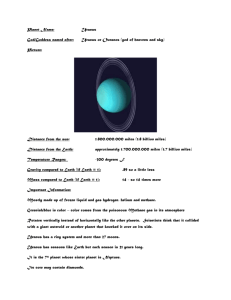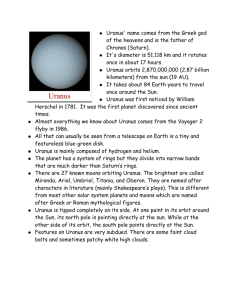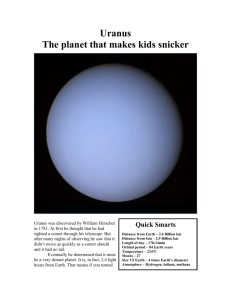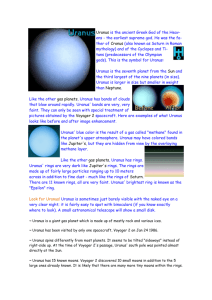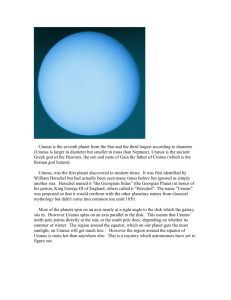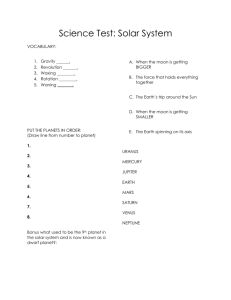Uranus
advertisement
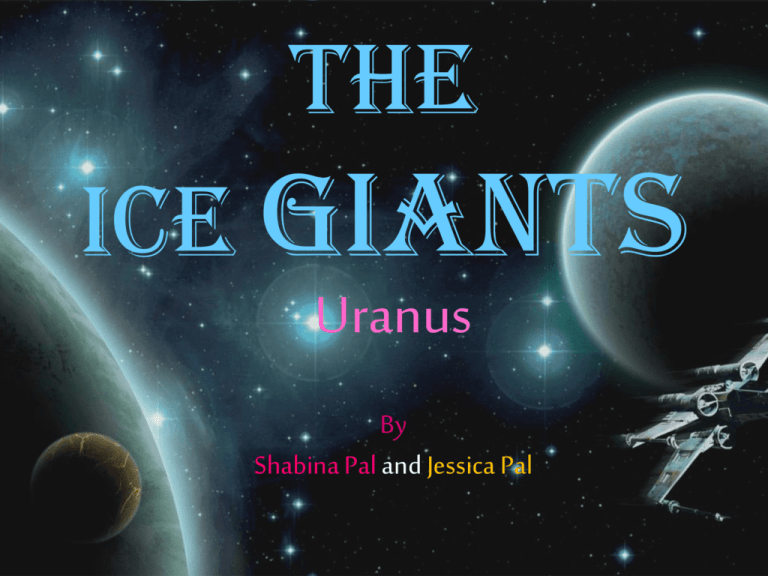
THE ICE GIANTS Uranus By Shabina Pal and Jessica Pal Introduction The planet we will be discussing is Uranus. Uranus, along with Neptune, is known as the Ice Giant. In this presentation: We will give you information about the planet, such as: The mythology behind the planets’ name and its discovery Planets’ Orbit Their Rotation Their Size Composition and Temperatures Surrounding of the Planets: moons and rings The effects that the planets’ composition has on human bodies More information about past, preset and any future scientific research about them Uranus is the 7th planet in the solar system. URANUS The naming game Uranus is named after the Greek God Ouranus, the lord of the Heavens. This name was chosen in addition as the logical addition to the series: for Mars (Ares in Greek) was the son of Jupiter, Jupiter (Zeus in Greek) the son of Saturn, and Saturn (Cronus in Greek) the son of Uranus. What is anomalous is that, while the others take Roman names, Uranus is a name derived from Greek in contrast to the Roman Caelus. Many names were proposed for the new planet, including "Hypercronius" ("above Saturn"), "Minerva" (the Roman goddess of wisdom), and "Herschel." To flatter King George III of England, Herschel himself offered "Georgium Sidus" ("The Georgian Planet") as a name, but that idea was unpopular outside of England. German astronomer Johann Bode, who detailed Uranus' orbit, gave the planet its ultimate name, URANUS. The Lord of the Heavens, URANUS URANUS The first discovered planet Uranus is the first planet to be discovered by scientists using a telescope. Although Uranus is visible to the naked eye, just like the classical planets — Mercury, Venus, Mars, Jupiter, and Saturn — it was long mistaken as a star because of the planet’s dimness and slow orbit. British astronomer Sir William Herschel discovered Uranus accidentally on March 13, 1781, with his telescope while surveying all stars down to those about 10 times dimmer than can be seen by the naked eye. One "star" seemed different, and within a year Uranus was shown to follow a planetary orbit. Sir William Herschel URANUS Orbit Uranus orbits the Sun on its side. Uranus revolves around the Sun once every 84 Earth years. Its average distance from the Sun is roughly 3 billion km (about 20 AU). http://upload.wikimedia.org/wikipedia/c ommons/7/76/Uranus_Orbit.gif The inclination of the planet to the Ecliptic plane is of 0.772 556°, almost on the same plane of the Sun’s Ecliptic plane. The Unusual Rotation of Uranus The unusual tilted axis is said to be caused by a single large impact on the planet. Another unusual fact about this planet is that the moons also lie on a 98 degrees plane. Theories state that this is a consequence of collisions with other objects in space. http://www.youtube.com/watch?v= Zo_MkCNU4FM http://hubblesite.org/newscenter/archive /releases/1999/11/video/b/ S I Z E • The diameter of Uranus is 51,118 km across. • The planet is about 4 times bigger than Earth and you could fit 63 Earths inside Uranus, and still have some room to spare. • The mass of Uranus is about 14.5 times more massive than Earth’s mass, but it is only 1/20 of Jupiter’s mass. Composition It is believed that Uranus has three different layers inside it: the rocky core, which is in the center the icy mantle, which surrounds it (largest layer) made of hot, dense fluid which is comprised of ammonia, water. In fact, most astronomers refer to Uranus’ mantle as the water-ammonia ocean the outer gas layer made up of helium and hydrogen Atmosphere Uranus' atmosphere is composed mainly of hydrogen, 83% and minor amounts of helium, 15 %. Methane is present in minor amounts, and probably forms most of the clouds seen by space probes and telescopes. Uranus and Neptune both appear blue because methane strongly absorbs light of other wavelengths. http://planetfacts.org/massand-density-of-uranus/ The Uninteresting Planet! - 1986 Not much was known about Uranus’ surface and atmosphere till January 1986, when Voyager 2 flow by the planet. By the data collected the planet seems to be inactive and scientists found it really uninteresting and boring at the time. This was considered be caused by the great distance from the sun, and therefore the energy coming from the sun was insufficient to heat up Uranus’ atmosphere. Voyager 2 Look Back at Uranus : Image from Voyager 2 in January 1986 showing the Uranian crescent. The pale blue colour of the planet is obvious. Astronomers are still not convinced about this, and debating between this being usual, or extremely slow phases are going on with the planet’s atmosphere. New Studies 2003- 2005 In 2003 and 2004 the ground-based 10-metre Keck II telescope in Hawaii took some pictures of Uranus and something unexpected was revealed: the planet now showed clouds, spots and several belts. This suggested that Uranus might be more dynamic than once thought, and further studies into these atmospheric outbursts or some periodic behavior may be revealed in the years to come. The high tilt of the rotational axis might have significant effects. The temperature along the equator in 2005 was noted to be -150°C. TEMPERATURE RANGES ON URANUS Temperatures at the very edges of the atmosphere are about −220°C (53K) warming slightly to −197°C (76K) Weather Winds can blow up to around 200 meters/seconds in the upper atmosphere. Uranus can be really really stormy. An equivalent of 3 million square miles on Earth. In other words, considered on Uranus, this kind of storms are usual and common there, and are barely detectable from Earth, but if the same storm would be brought on our planet it would destroy entire continents as USA in no time. Seasons On Uranus A day on Uranus is 17 hours, 14 minutes and 24 seconds long. Picture taken by the Hubble. For part of the year on Uranus, the Sun appears to be move throughout the sky, just like we have on Earth. But then, as the year goes on, one hemisphere is in light, and the other is in darkness for an entire season. In other words, a day on Uranus is the same as a season: either it is dark or it is light. So from this we can say that there are only two seasons on Uranus. Uranus has 27 confirmed natural satellites in its orbit. Uranus has 5 major moons. Uranus has 13 rings. They are named using Greek symbols and other numerical values. In order of increasing distance from the planet, they are 1986U2R, 6, 5, 4, Alpha, Beta, Eta, Gamma, Delta, Lambda, Epsilon, Nu and Mu M O O N S + R I N G S The rings of Uranus were first discovered in 1977 while scientists were looking the sky and they saw that when a star was occulted by Uranus, and that there were some dips in the brightness of the star. http://csep10.phys.utk.edu/astr16 1/lect/uranus/rings.html Picture taken by the Voyager 2 The satellites of Uranus orbit the planet in the same plane of the equator of Uranus. MIRANDA, The Unique Moon of Uranus Astronomers once believed that Miranda had been shattered to pieces and reassembled several times throughout its long history. But more recent theories suggest that the upwelling of partially melted ices may be responsible for these curious surface features. The real reason is still a mystery. http://www.seasky.org/solar-system/uranusmiranda.html URANUS IN THE SKY Uranus Among the Constellations Constellation. Year Year Pisces 2009 — 2011 Cetus 2012 Piscis 2013 — 2017 Aries 2017 — 2023 Taurus 2024 — 2032 Gemini 2033 — 2039 Cancer 2039 — 2043 Leo 2044 — 2051 Virgo 2052 — 2061 Uranus is not visible at naked eye. If you have an accurate telescope, then you can easily identify Uranus by the bluish/greenish color that it has. Uranus, imaged at high power on August 28, 2007, with a 12.5-inch reflector using the stacked-video technique. Visually Uranus appears much more white than blue-green. S&T: Sean Walker Best Times To Look For Uranus The best times to look for Uranus throughout the year are between September through November . During this time the planet is visible in the evening sky. It is possible to spot it early in January, but before dawn. No set dates for now for Uranus visibility for 2012. http://www.nakedeyeplane ts.com/uranus.htm From January to May it is impossible to spot the planet because it is close to the Sun. Voyager 2 The first approach to Uranus was done on January 24, 1986. Voyager 2 was sent by NASA Voyager 2 was the first and only probe that travelled from Earth to Uranus and flew by it and sent back data. From what Voyager sent back, scientists concluded that Uranus is featureless, but it has a faint haze over the North Pole. http://www.youtube.com/ watch?v=r46QdcnAYeU Future Explorations Plans For Uranus British scientists proposed a plan to launch a satellite in that could shed new light on the mysteries of the frozen planet. They plan on sending a probe on a 15-year journey to the distant planet. Scientist want to find the answers to the mysteries of Uranus: - Why does it give off so little heat? - Why is it tilted on its side, rolling about the solar system like a ball, causing half of the planet to face away from the sun for 42 years at a time? It is an expensive project, but it is planned to be lanced in 2021 Further researches on Uranus would lead to scientific discoveries of a planet that is so different from the other planets. Hopefully we will hear more about the planets in about 24 years, if not more. ( 9 years before probes will be sent, and 15 years before the probes will reach the planets.) HUMANS ON URANUS If a human would ever land on Uranus, it would be impossible to survive. There is no Oxygen, therefore inability of breathing. Gravitational force on Uranus is just a little bit higher then Earth’s. This means that gravity would not crush a human boy on Uranus, but the atmospheric pressure might. But all these are suppositions made on the evidences we have, because not a lot about the surface of Uranus is known up to date. The atmosphere is so dense that a human body is unable to stand, therefore the pressure would crush the person down. The planet is made of the so called “waterammonia ocean”, so there is no land for human to stand on. Also the inner side of the planet is extremely hot – Green house effect ( extremely dense atmosphere) Humans would freeze to death on the planet. A 100 pound person would be weighting approximately 90 pounds on Uranus. Many of us may have thought that we would weight a lot more or a lot less on Uranus. This is because the little difference in the Gravitational field on Uranus compared to Earth’s. NOW FIND OUT HOW MUCH YOU WOULD WEIGHT ON URANUS: http://www.exploratorium.edu/ronh/weight/ Interesting Facts: • Well, Uranus’ rotation. It rotates on the side, unlikely other planets. • Uranus has a really thick atmosphere, but it is still the 2nd least dense planet, after Saturn! • Uranus is the 3rd largest planet in the solar system, and the 4th massive planet. • The rings of Uranus have dust layers around them. • As said, not much is known specifically about the surface of the planet, but hopefully more will be found out in the future ( hopefully while WE are still alive!!!) This is a link that summaries the important things about Uranus http://science.nationalgeographi c.com/science/space/solarsystem/uranus-article/ REFERENCES http://en.wikipedia.org/wiki/Uranus http://www.space.com/45-uranus-seventh-planet-in-earths-solar-system-was-firstdiscovered-planet.html http://www.optcorp.com/edu/articleDetailEDU.aspx?aid=1450 http://news.discovery.com/space/home-run-neptune-completes-first-orbit-sincediscovery.html http://planetfacts.org/orbit-and-rotation-of-uranus/ http://www.bobthealien.co.uk/uranten.htm http://www.dailygalaxy.com/my_weblog/2011/10/-uranuss-weird-sidways-orbit.html http://en.wikipedia.org/wiki/Rings_of_Uranus http://www.seasky.org/solar-system/uranus-miranda.html http://www.planetfacts.net/Uranus-Facts.html http://nineplanets.org/uranus.html http://planetfacts.org/planet-uranus-facts/ http://science.nationalgeographic.com/science/space/solar-system/uranus-article/ http://www.enchantedlearning.com/subjects/astronomy/planets/uranus/ http://www.solarviews.com/eng/uranus.htm
